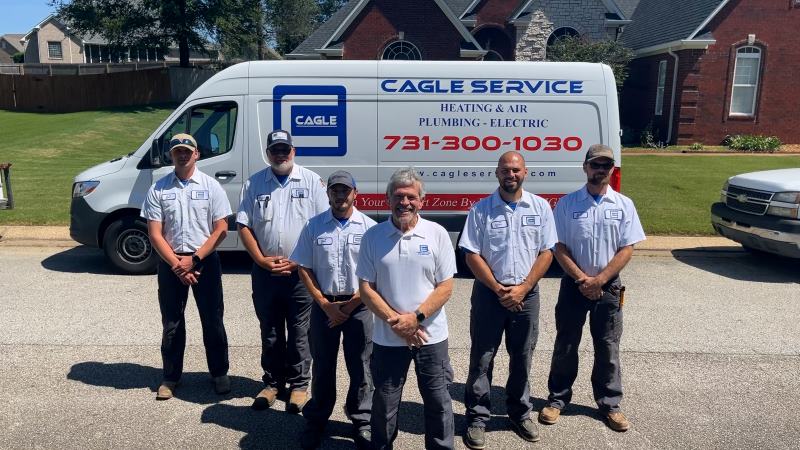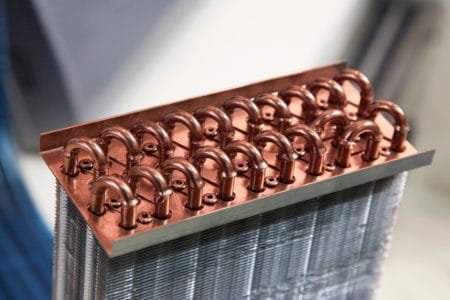Have you ever asked yourself “What is a heat exchanger?“
Some of us know that it plays an important part in the operation of our furnaces, but what is a heat exchanger exactly and what does it do? In this post we hope to shed some light and information on this topic for you!
What is a Heat Exchanger?
The heat exchanger in a furnace separates the combustion process from your breathing air. Air is heated as it is blown across the hot metal surface of the heat exchanger. The heated air is then distributed through the house to warm the house.
The heat exchanger must have an air (and gas) tight seal to separate the gasses inside the heat exchanger from the breathing air passing over the outside surface. This is because the flue gasses can be poisonous. Carbon Monoxide Gas and contamination of the breathing air by these gasses pose a health risk and can be fatal.
Now that we’ve answered the question of “What is a heat exchanger?”, let’s dig down into some common issues they have and some tips that can help you!
Why do Heat Exchangers fail?
All heat exchangers fail eventually. This is because of metal fatigue. Metal when it is heated up expands, and when it is cooled off contracts. This expansion/contraction cycle is part of the normal furnace heating process. Over time this constant expansion and contraction has the same effect on a heat exchanger that bending a paperclip back and forth, it breaks. Upon this failure, contamination occurs and it is no longer safe.
While heat exchangers are typically manufactured to last between 10 – 20 years, many factors can accelerate the process of heat exchanger failure. These factors usually fall under the categories of poor maintenance, poor initial system design and installation, or poor equipment design by the manufacturer. Any one or a combination of these factors can result in a heat exchanger failing in a few short years.
How can you know when a Heat Exchanger has failed?
A heat exchanger must be visually inspected on a regular basis. Visual observation of light or water passing through the breach is positive confirmation of a crack or hole in a heat exchanger.
What are the Safety Concerns of a faulty Heat Exchanger?
When it comes to gas appliance and furnace safety, homeowners may assume that the flammability of gas is the main hazard to guard against. However, Bob Underwood, technical training manager at Estes Services in Atlanta, says that the more important safety concern with regard to gas furnaces is actually the accidental venting of carbon monoxide into the home.
“There are high-temperature limiting devices on furnaces to protect against fire,” he points out, “so the primary problem is that carbon monoxide could leak into the home.”
In a properly functioning gas furnace system, the flue transfers carbon monoxide (and other gases produced by combustion) safely out of the house; a damaged or blocked flue can send them into the home instead.
A gas furnace’s heat exchanger is another potential source of leaked carbon monoxide. The heat exchanger contains the gas combustion chamber. As air is circulated through the HVAC system, it passes over the heat exchanger and absorbs thermal energy before it’s circulated throughout the house.
Over time, the heat exchanger can crack or separate, allowing carbon monoxide to enter the house. Bob not only knows why cracks in heat exchangers sometimes develop, but he also knows what homeowners should do when this problem occurs as well as how regular maintenance can help prevent it in the first place
What are the options if a Heat Exchanger is bad?
There are only two options if a Heat Exchanger is bad:
- Replace the heat exchanger or replace the furnace. If the heat exchanger is under warranty, this option is a good way to go unless it is unavailable in the time frame needed, which can be immediate in cold weather.
- The other factors are energy efficiency and cost of service which can make replacing the furnace a preferable option even if the furnace is under warranty and available. If a furnace is out of warranty the preferable option is to replace the furnace.
How does Cagle Service provide the highest level of confidence possible?
There are two areas where a high level of confidence is vital for you:
- To have the assurance that if there is a breach in the heat exchanger that it is discovered. To give you this assurance, Cagle Service has made a substantial investment in inspection systems for all of their service technicians to eliminate any uncertainty about the integrity of your furnace and to give you maximum peace of mind about your safety.
- To have the assurance that if the heat exchanger is diagnosed as bad, that it really is bad.
If you would like more information or if you think you need a possible furnace repair, simply give us a call at 731-300-1030. We’d love to help.
At Cagle Service, your satisfaction is our goal!



